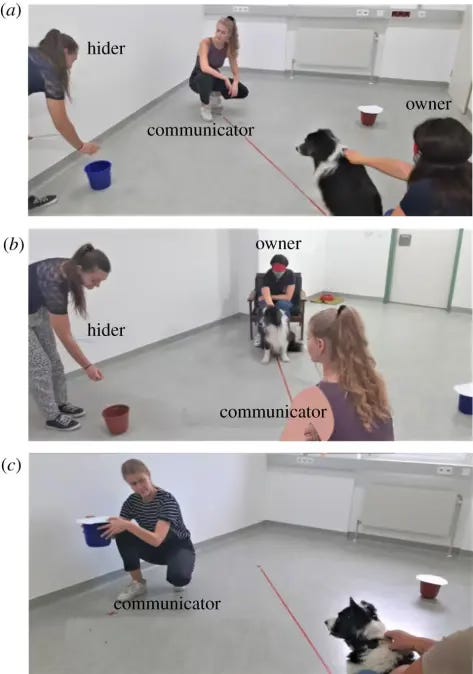1. “Come!” “Sit.” “Speak.” “Down.” “Shake.” “Heel!” “Roll over!” These words are well-known among dog owners. We teach them to our faithful companions so they will learn to understand rudimentary commands and do our bidding. It’s a task dogs are evolutionarily primed for. They keenly observe humans’ hand gestures, body movements, facial expressions, and especially our eyes to try to interpret what we want and how we feel. The result of this culturally and biologically evolved status quo is that the human-dog relationship is often one-sided. Dogs focus on the wants and whims of humans far more than people consider the emotional needs of dogs. As a result, dogs are better at understanding humans than we are at understanding them. (via Big Think)
2. For most employees on Governors Island, summer is the busiest time of the year. But two of those workers have enjoyed a quieter, less hectic season: Aspen and Reed, who are dogs. Their job is to shoo flocks of geese away from the island’s expansive lawns — often on an overnight shift — but there are typically fewer geese in the dog days of summer than in the colder times of year. On a recent August morning, there was no work to be done — no geese in sight — so Reed, a one-year-old border collie, decided to be a silly goose himself. He ran after a ball and a garbage truck, chewed on a stick and wiggled on his back in the grass. (via The City)
3. Dogs are not allowed off leash at a popular hiking and dog walking spot called the Nature Reserve in Lewes, England. Many of the park’s native wildflowers and grasses had disappeared after decades of use, leaving it sparse and overly trodden. “It was a degraded woodland,” said Dylan Walker, a wildlife manager in Lewes. “We weren’t seeing any plants coming up. People were loving our urban nature reserve to death.” So dog owners were surprised in March when they saw an unusual offer: They could bring in their dogs and let them run free in the reserve, as long as the pups would wear backpacks while frolicking. The backpacks would be filled with seed mix to help reseed the ground. (via The Washington Post)
4. If Ruth Dalton was telling you a story about someone, you would sometimes have to stop her and ask: Are you talking about a dog, or a human? Animals were never just animals to Dalton, the beloved 80-year-old dog walker killed Tuesday during a carjacking — they were people too. Her legacy of care for pets, grandmotherly love and enduring magnanimity has reverberated throughout Seattle. Dalton was killed Tuesday morning during a carjacking when a man allegedly backed over Dalton before speeding away in her car. Dalton was the owner of Grandma’s Critter Care, which she began in 1989 to pay for her granddaughter, then 5-year-old Melanie Roberts, to attend a private Christian school. Even though Dalton had accomplished what she set out to do, she found she didn’t want to leave the job. (via The Seattle Times)
5. A team of trained dogs has been lending their towing strength, swimming endurance and current-detection ability to rescue people from drowning at a popular beach in southern Spain. Decked out with special life vests, the dogs - mostly the Labrador and Newfoundland breeds - patrol the Levante beach near Malaga alongside their handlers, whom they also accompany on jet skis and rescue boats. (via Reuters)
6. Your dog doesn’t feel even a little bit guilty for jumping up on the counter and scarfing down an entire baked chicken. He’s just afraid because you’re yelling at him. The same applies when he’s torn up an expensive new pair of shoes or pooped on an Oriental carpet. Dogs don’t really have what human beings would call a conscience. If you leave a baked chicken where they can get it, they’re going to gorge themselves until they can’t eat anymore, and then barf on the sofa and take a nap in your bed. Behavioral rules apply only when you’re there to enforce them. You don’t want Ace and Stanley wallowing around in the bed? Close the bedroom door, or put them in the yard. Otherwise, dogs aren’t a whole lot more obedient and conscience-stricken than cats — just more social and demonstrative. (via Chicago Sun Times)
7. The evolution of the domestic dog took place over a long period of time, during which wolves and dogs continued to interbreed—muddying the waters when it comes to analyzing canid fossils and even DNA. In considering canine fossils, researchers examine their morphological features, such as size and arrangement of the teeth, size and length of the snout and mandibles, and the shape of the skull. The researchers then compare them to modern dogs, modern wolves, confirmed early dog fossils, and prehistoric wolf fossils. Some features of ancient dog fossils include short skulls and snouts, crowded and smaller teeth (due to the shortened snouts), and wide palates and craniums. Additionally, scientists can use an advanced bone-measuring technique called geometric morphometrics to analyze the curves of a skull so individual specimens can be more easily compared to each other. (via National Geographic)
8. Private equity groups are facing pushback on both sides of the Atlantic after their consolidation of local veterinary practices was followed by sky-high prices to treat our beloved pets. While closer examination of their activities is long overdue, some of these PE “fat cats” aren’t doing as well as is often assumed when it comes to animal care: In the UK — one of the world’s most concentrated veterinary markets — profit margins and valuations have come under pressure, acquisitions and customer demand have slowed, while staff are going on strike for higher pay. (via Bloomberg)
9. Chris Hodder is an army veteran living with post-traumatic stress disorder (PTSD). It can be an isolating world to inhabit — but that changed when he was paired with service dog Bella. "She just walked in and sat straight down next to my feet, it was sort of like an instant bond," Mr Hodder said. "She's changed my life for the better, because where I was apprehensive, where I had anxiety and was always on edge, she's taken that away.” Bella was initially trained as a guide dog, but was found unsuitable for the gig. So, she was taken in by Integra Service Dogs Australia — a charity based in Canberra that gives Labradors not suited to being guide dogs a second chance. (via ABC News)
10. Videos of “button dogs” often go viral on social media as they tap soundboards with prerecorded words such as “walk,” “park” or “mom.” But are the pets really communicating or are they just well-trained? Although new research doesn’t fully answer that question, it begins to explore the world of button dogs and how they react to both the buttons and their humans. The study, published in the journal PLOS ONE and conducted by scientists at the University of California at San Diego, is the first in an expected series aimed at ultimately answering the larger question of whether the dogs themselves can learn to communicate their desires by tapping buttons. (via The Washington Post)
Dog Photo of the Week
Photo by Brandy Yi, “How Anthony Rubio Turned Canine Couture Into Art and Advocacy” (via Co)
Dog Video of the Week
Video by Jeff Skversky, “Phillies Minor League Bat Dog Debut Gone Wrong”.




